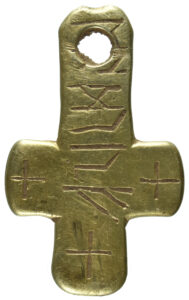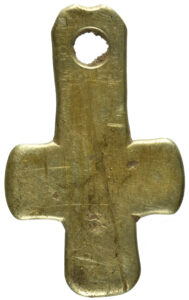A gold cross pendant discovered near Berwick-upon-Tweed in Northumberland, England, is inscribed with the previously unknown Anglo-Saxon name “Eadruf.” The solid gold cross is of a simple Latin form with the longest arm at the top. It is an inch long and .6 inches wide on the crossbar. Runes were incised down the length of the arm to just past crossbar. The foot of the cross and the horizontal arms are inscribed with equal-armed crosses. It is perforated at the apex and the crude hole filed to smooth some of its rough edges, but this was done after the runes were carved, likely after its original top-mounted loop was lost so it was modified to be suspended from a hole instead. It dates to between 700 and 900 A.D.
The pendant was found last year by a metal detectorist on the banks of the River Tweed. There are very few comparable examples. Most early Anglo-Saxon crosses are equal armed, and none have been found before with runic inscriptions.
When the finder reported it the Portable Antiquities Scheme, they consulted several specialists were enlisted to examine the cross and translate the inscription.
From the report by Professor John Hines of Cardiff University:
It seems likely from the width and shape of the cuts that the three incised crosses at the ‘head’ end of the shaft and in either arm were cut at the same time as the runes. Six runes can be identified, reading left to right from the ‘foot’ of the shaft, with the first two drilled through by the wide perforation. […]
Artefacts such as this are quite often inscribed with the personal name of a person with whom the object had been associated (usually to be assumed as the possessor, if nothing else is indicated). Old English personal names beginning Ead- (‘happiness’, ‘fortune’) are common, but the only two known with a second element beginning r- are Eadred and Eadric. No personal-name element ruf can be identified in any Germanic language, and Eadruf would therefore be a hitherto unknown and etymologically mysterious name.
The findspot is also mysterious, in that there are no archaeological remains of an early medieval settlement in the area. At the time the pendant was made, the Tweedmouth area was part of a group of holdings belonging to the Holy Island of Lindisfarne, but while there are records indicating a church or abbey may have been in the vicinity, there is zero archaeological evidence of any structure from the early Middle Ages. Artifacts have been thin on the ground too. Other than this cross, the only other object from Anglo-Saxon period found here is a late 10th century copper-alloy strap fitting.


Unsure, if I am convinced about this – To me, frankly, the ᚱ(r) looks rather weird, but what do I know?
…So from left to right, we would have…
———
ᛖᛠᛞ..ᚢᚠ
Ead..uf
…But what –very much in contrast to what looks like “ᚢᚢ”– about the ᚢ and the ᛚ ?…
ᛖᛠᛞ ᛚᚠ
Ead..lf
ᛖᛠᛞᚢᛚᚠ
Eadulf
———
Yes, I know. Maybe not exactly, what we would consider a politically correct solution. Thank God, there is not what even closely resembles an ᛜ, ᛝ or an ᛟ :facepalm:
———
PS: In Southern Franconia, on the other hand, there is the town of “Ruffenhofen”. There is even a Roman fort (“robur”, strenght = “ruff”?). Feel free to have a look at:
roemerpark-ruffenhofen.de/index.php/en/gallery
limeseum.de/index.php/en/
Or the final 4 runes as ᛞᚢᚢᚠ giving Eaduuf… as a possible misspelling of Eaduulf, which is itself a relatively common spelling of Eadwulf, a common name.
Good point, Sir :yes: …as far as I am concerned, I did not even think of that at first, but what we would have here, appears to be a rather clear case of “Double-U” (or “W”).
Cf. the ‘Old Saxon Baptismal Vow’:
—
‘End ec forsacho allum dioboles uuercum and uuordum, Thunaer ende Uuôden ende Saxnôte ende allum thêm unholdum thê hira genôtas sint’ (“And I forsake all devilish works and words, Thunar and Wodan and Saxnot and all those Unfriendly that their companions are”).
—
Though the piercing renders a reading uncertain, are the first characters bind-runes, E EA A, and the second bind-runes DU, giving the name E EA A D U U F, EEAADUUF, not necessarily a misspelling, but a pronunciation spelling, of Eadwulf?
At least that is what makes sense to me, Dave – i.e. no misspelling, if the interpretation as “ᚢᚢ” is correct.
As you –and the ‘Other Sceptic’– have already put it, ..or in other uuords:
——–
ᛖᛠᛞᚢᚢᚠ
Eadw(l)f
——–
:hattip:
Any bias in “Schicklgruber” see it as “Eadulf”?
Don’t worry and be cool, probably not the “bias” that you are seemingly contemplating about, Scott.
:hattip:
In fact, it is a “Simpsons” character:
en.wikipedia.org/wiki/Mr_Burns
———-
“Charles Montgomery Plantagenet Schicklgruber “Monty” Burns, usually referred to as ‘Mr. Burns’, is a recurring character and antagonist in the animated television series The Simpsons.”
———-
The scratches on either side of the piercing suggest this was attached (perhaps with a rivet) to some other object (band of a crown?), then not too gently pried off.
It’s no wonder that it was lost. The roughness of the hole would cut through whatever material attempted to hold it.
@Virginia, in case there was indeed a rivet, it is actually the hole that was holding the cross in place, i.e. not the other way round. It would explain –if so– that this is not at all a “pendant”, but had been mounted the other way round.
There is an ‘Eadwulf’ reigning in 705AD for two months as king “Eadwulf I” over Northumbria.
Near Bamburgh, civil wars with Osred’s kindsmen took place, in which Eadwulf had to surrender, and thus, Eadwulf had subsequently been exiled to “either Dál Riata or Pictland”, where he –according to the Annals of Ulster (Annála Uladh)– died in 717AD: Ead(w)ulf, “02.717 Etulb mac Ecu(i)lb died“.
The findspot of “Tweedmouth” is not necessarily a non-perfect fit, or at least not necessarily mysterious. Of course, I do not speak Irish myself, nor have I seen the original manuscript, but at least the Irish did not really seem to have a particular “bias” for the ‘vv‘ in the name of the ‘son of Ecuilb/Ecgwulf’..
–“D’oh!” :ohnoes:
————
PS: …“Eadulf”, or not, I would be interested, if they have at least an opinion about all this in Cardiff.
Wondering where the gold came from and how it got to England!
There are ancient gold mines in Wales.